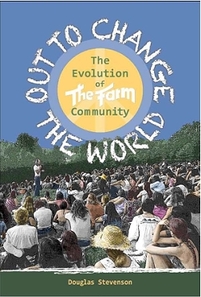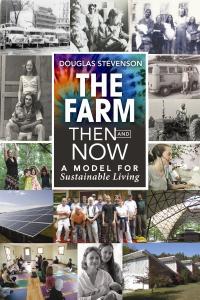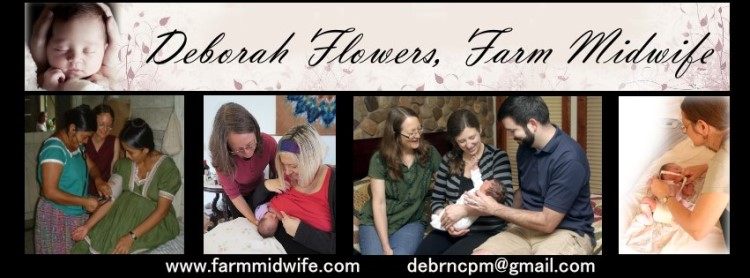Farm Fresh News - August 2020
|
In this issue:
|
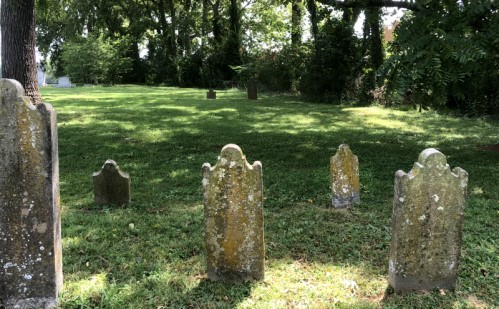 A slave cemetery, about 10 miles from The Farm. |
Black History Matters
When The Farm Caravan of buses landed in Tennessee, the draw was inexpensive land, with a fantastic growing season and lush forests. There was some trepidation about moving to the South. The movie Easy Rider had left a lasting impression.
However, folks soon discovered the friendliness of the people in the south, otherwise known as southern hospitality. My wife and I were born and raised in Kentucky, so moving to Tennessee didn’t feel that different to us. Although we hippies were bit strange looking, especially with our long hair, the locals accepted us. Then again, for the most part, we were white.
|
The Farm is located on a high plateau above the vast fertile farmlands of the Nashville Basin. This area was the heartland of the Old South, and Antebellum Mansions of former plantations dot the landscape. These plantations were built and farmed by hundreds of slaves. The Ku Klux Klan was founded in a small town about 30 miles east of us.
Like the rest of the country, over the last many decades, race relations have improved, but Confederate flags are everywhere, along with Trump bumper stickers.
At the same time, we are the home state of Al Gore (who did not win Tennessee), Democratic Governors have regularly occupied the State House, and the larger cities often have Democratic mayors.
|
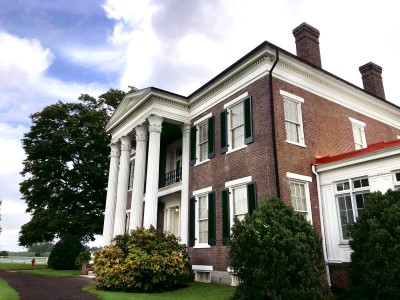 Rippavilla |
Over the last couple of months, I have been involved in a new project, documenting the history of the African American/Black community of the county next door. I've been visiting and photographing many of the slave cemeteries that still exist. I've done interviews with a family who lost an uncle (he was 17 at the time) to the last social lynching there in the late 1930s. I've become immersed in learning what the Black community has been through and gaining a deeper understanding of why racism still lingers and has such a strong hold in our country today.
We all owe a debt to the Native Americans whose land we are on, and the African Americans whose ancestors built this nation, sacrificed their lives for its wealth, and still feel the oppression of a society stacked against them. One place we can all start is to learn more about our history.
“History, despite its wrenching pain cannot be unlived, but if faced with courage, need not be relived.” Maya Angelou
“History will record the greatest tragedy of this period of social injustice not with the strident clamor of the bad people, but the appalling silence of the good people.” Martin Luther King jr

Will, was born 1802, died Jan. 26, 1862
The paternalistic attitude of slave owners was mainly expressed on servants in the "Big House."
They were more likely to be buried in a cemetery with a headstone. Giving him only a first name reflected the disregard of African American family ties.
Some places to start:
The African Americans 2013 Watch it on PBS, Amazon Prime, YouTube
This six-part series provides an in depth examination of the African-American experience across five centuries, from origins of slavery and the New World to the Jim Crow and Civil Rights Era, until present day affairs.
This six-part series provides an in depth examination of the African-American experience across five centuries, from origins of slavery and the New World to the Jim Crow and Civil Rights Era, until present day affairs.
13th 2016 Watch it on Netflix
This feature length documentary explores the loophole in the 13th amendment ending slavery, except for the punishment of a crime, leading to the mass incarceration of African-Americans and the for-profit prison system.
This feature length documentary explores the loophole in the 13th amendment ending slavery, except for the punishment of a crime, leading to the mass incarceration of African-Americans and the for-profit prison system.
peace,
Douglas
______________________________________________________________________________
More Life in the Garden - Raspberries!
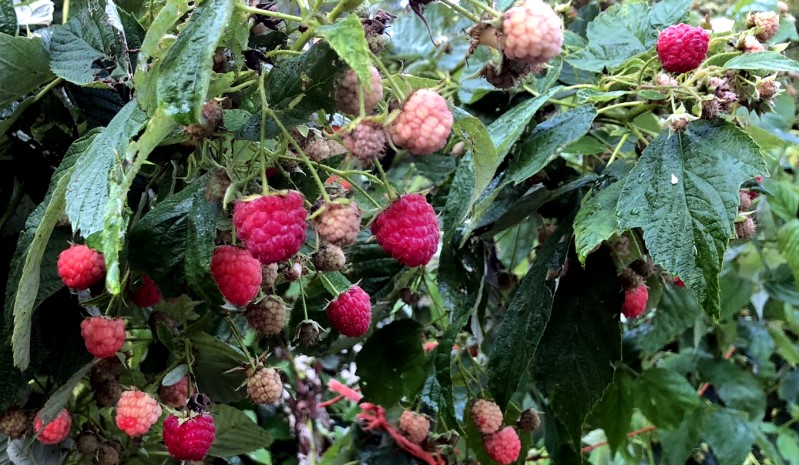
These plants are 10 feet tall and loaded with berries.
We decided to grow raspberries again last year and started with about 16 plants which we purchased from a mail order nursery. They arrived in the spring as dead looking sticks about foot long, with a few hairy roots at one end. By the end of the summer, a few had died, but most had put out leaves and grown a few feet in length.
This variety of raspberry is capable of putting out two crops per year, one in June and the second in the fall. We did not prune these at the end of the season but left them to be the "floricanes," the ones that produce an early crop in their second year. Once they have born fruit, these vines die, turning dark brown and woody. So at the end of June, we cut these old canes and removed them from the patch, leaving the new first year growth or "primacanes."
The primacanes that came up from the roots of our planting last year virtually exploded from the ground. There were so many, we transplanted some into a second row. Those primacanes are now 10 feet or more tall, with huge heads filled with berries, and often there are several heads on one plant. The canes get so tall they require support with posts and wire trellising. The fruit on the heads is very heavy requiring support as well or they may break.
We had trouble in June and for a couple weeks in the fall with raccoons climbing into the patch and breaking canes with their weight as they went after the berries. We caught three in the have-a-heart trap, along with a possum, and have not noticed any more disturbance since relocating them about 5-7 miles away.
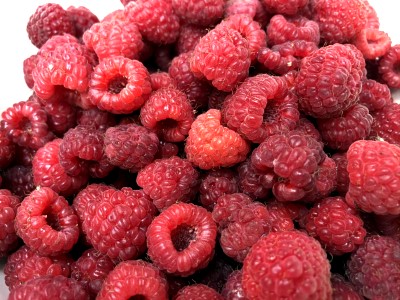
I am currently picking over a quart a day of raspberries! Our favorite way to consume them is with a bowl of chocolate "ice bean"!
Whatever we don't eat each day goes into the freezer for winter.
Whatever we don't eat each day goes into the freezer for winter.
______________________________________________________________________________
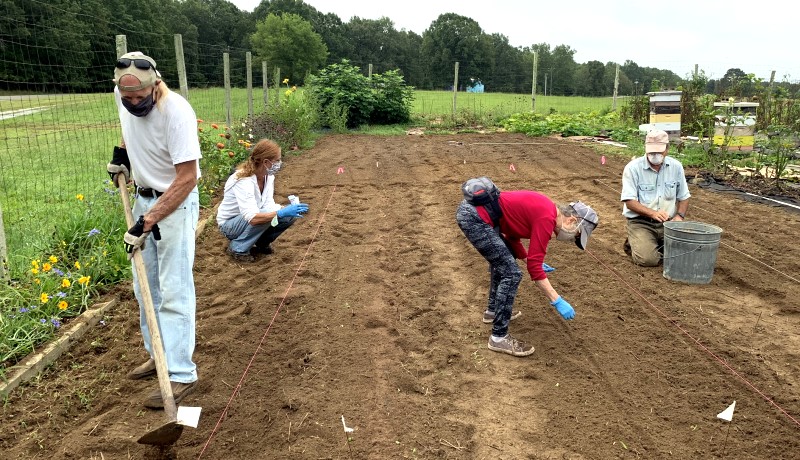
Planting a community kale patch
To help my friends in the community have some healthy greens to eat this fall and winter, I am dedicating a portion of my garden to a community kale patch. I tilled the ground a couple times to kill off the weeds after the last crop in this area, and then we marked off rows with string. We put down some organic fertilizer and green sand, a soil amendment, and used a hoe to mix it in. Next some volunteers planted the seeds. I am in the back pulling out any leftover weeds, putting them in the bucket. As you can see we are all socially distanced and wearing masks. Note the bee hives in the back from 2 swarms I caught this summer.
-----------------------------------------------------------------------------------------
Time for Kambucha!

My wife Deborah started making Kombucha 20 some years ago, before it became such a big thing. It's one of those projects that requires regular attention and maintenance, so she stopped, but we recently drank some a friend had made, and it was so delicious, we had to get some going again!
Drinking Kombucha ties into the current greater awareness about the benefits of eating fermented foods, delivering lots of beneficial flora to your gut. Typically you brew 14 cups of black tea and then add some sugar and 2 cups of your starter inoculant (fermented tea from your last batch), along with something called a SCOBY (Symbiotic Bacteria and Yeast), the white stuff floating at the top.
After a few days, you transfer the fermented tea to smaller bottles with a tight lid. This is when you flavor your Kombucha. We like putting in chunks of fresh or candied ginger, but our favorite is to add about a tablespoon of fresh raspberries! After a few days, the sugar in the raspberries have fermented to produce a delightful fizzy drink.
-----------------------------------------------------------------------------------------
A big thanks to everyone who has become a patron of Farm Fresh!
When you become a subscriber, your contribution helps spread the word about community based alternatives and the spiritual path.
Take this one small step to be part of the solution!
When you become a subscriber, your contribution helps spread the word about community based alternatives and the spiritual path.
Take this one small step to be part of the solution!
You can help keep Farm Fresh going by pledging $2, $5, or $10 a month, or by making a one time contribution.
Let me know your interests. Click here to take the survey. I look forward to hearing from you.
Peace,
Douglas
Watch my TEDx Talk: Out to Change the World - Living the Hippie Dream

------------------------------------------------------------------------------------------
I hope you'll make the effort to take a firsthand look at The Farm during one of my GreenLife Retreat Weekends, and that it will inspire you to pursue your dreams and find your chosen path!
Speaking Engagements
At the same time, I recognize that I can reach a lot more people if I go outside the community. One of my goals is to speak at colleges and universities where I can talk to young people about Right Livelihood, Service, and Finding Sanity in an Insane World. This is a time when people need to hear an uplifting message of hope.
If you are part of an organization, event, or school (or you just want to learn more about my life's work), I invite you to visit my web site www.douglasstevenson.com, where you'll find information on my lecture topics and how to bring me to speak in your area.
Thank you for your interest, and your support. I hope to see you down the road.
------------------------------------------------------------------------------------------------
------------------------------------------------------------------------------------
------------------------------------------------------------------------------------
My wife Deborah is one of the primary midwives practicing on The Farm right now. She is also a teacher with the midwifery workshops and our College of Traditional Midwifery. If you, a friend, or family member are considering a midwifery assisted birth, I encourage you to visit her web site and check out her podcast.

www.awakeningbirth.org - the Web Site
www.awakening birth.net - The Podcast
Her birth resource web sites for families seeking guidance on subjects such as
- Choosing a Care Provider.
- Health and Diet
- Challenges and Complications
- and much more!
- The Awakening Birth podcast is now available on iTunes or at www.awakeningbirth.net
Please spread the word to anyone in your circle who is thinking of having a baby, expecting, to your favorite midwife, or care provider. Please like us and give us a good review on iTunes. It helps!
GreenLife Retreats
A division of Village Media Services
PO Box 259Summertown, TN 38483
931-964-2590 - office / cell
Douglas@villagemedia.com
www.villagemedia.com
www.greenliferetreats.com
www.douglasstevenson.com
Douglas@thefarmcommunity.com
A division of Village Media Services
PO Box 259Summertown, TN 38483
931-964-2590 - office / cell
Douglas@villagemedia.com
www.villagemedia.com
www.greenliferetreats.com
www.douglasstevenson.com
Douglas@thefarmcommunity.com


